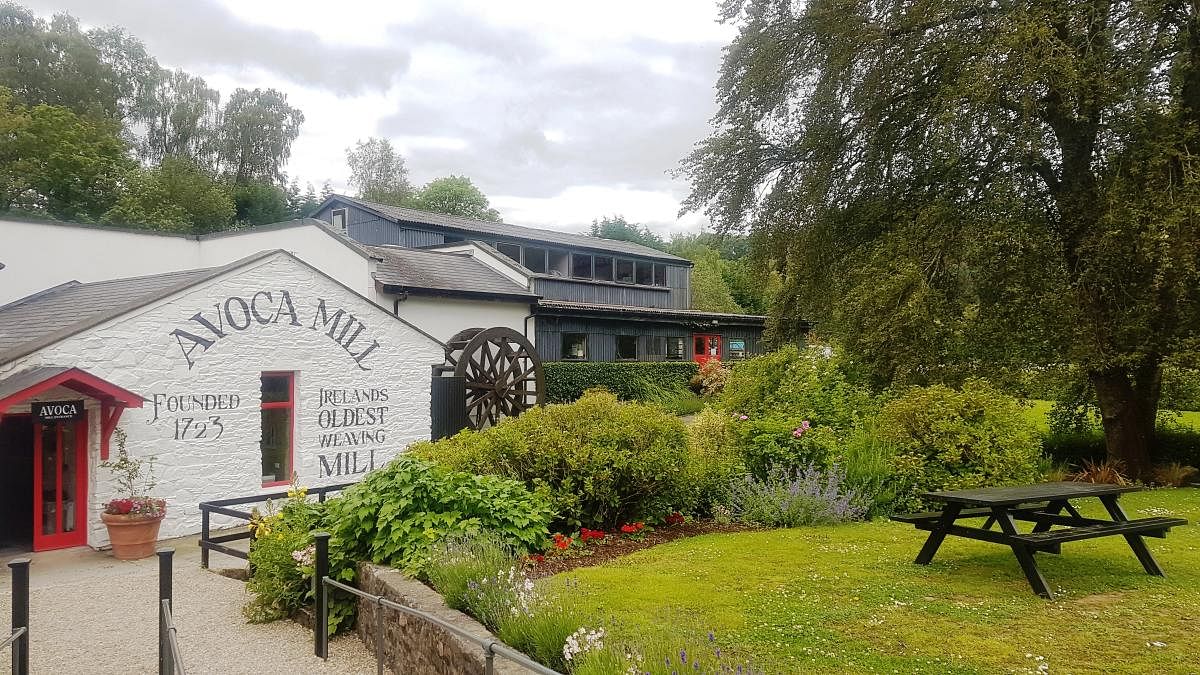
Within the wooden building in Avoca Village, Ireland’s oldest weaving mill was established in 1723. As I walk inside, I am greeted by wooden tables covered with hand woven shrugs, black and white photos peeking from white walls, an old handloom placed in a corner and coloured yarn displayed on shelves. The mill, which functions even today, gives an interesting insight into Irish weaving.
The tour normally starts with the story of the Wynne sisters — Winefred, Veronica and Emily — who looked after the mill in the 1920’s and introduced the concept of coloured yarn. At that time, the weaving, spinning and dyeing were done on-site. The sisters ran the mill till 1960 and under them the brand found its way to Paris, London, Italy and the United States. The trio is thus duly credited for turning a local business into an international brand.
It’s a ‘Wynne Wynne’
I learn that while Veronica and Emily focused on designs, Winefred was responsible for painting thimbles and taking care of the botanical garden. The sisters employed 80 people which was a commendable number in the 1920s. Apart from this mill, the other source of employment at the village was mining copper, zinc and gold. The mill also has royal connections. While Prince Andrew, Duke of York was gifted an Avoca shawl when he was a baby, a waistcoat for King George VI was hand woven here. Many of the wedding gifts for the Queen Mother were sourced from the mill, while princesses Elizabeth and Margaret have worn tweed coats woven at the mill, and Camilla, Duchess of Cornwall, visited Avoca last year and bought blankets. As the tour progresses, the story of the mill unfolds and it changes hands from the Wynne sisters to the Pratt family who further expanded the business. When the mill started in 1723, raw uncoloured yarn was woven to make tweed fabric or blankets. Today, Donegal, mohair, cashmere, lambswool and merino are woven on handlooms and power looms to make stoles, shawls, shrugs, scarves, blankets and fabric. Donegal is a special yarn spun in Ireland. It is basically created from raw wool and the finished product has got a multi-coloured flecked finish to it. Mohair is made from the wool sourced from the Angora goat and it is bought from South Africa. Mohair is mostly used to make blankets and the yarn is woven in loop form. After the blankets are washed, they are brushed to give them a soft finish.
Warm & light
Cashmere is created from the Cashmere goats of Kashmir. Its advantage is that it is warm without being bulky. Also despite being soft and light, the yarn is quite strong. Lambswool is got from the first shearing of a sheep when it is around seven months old. This yarn is soft and elastic. Merino taken from merino sheep is soft, fine and is got from Spain.
As I continue to walk from room to room, I see a weaving legacy come to life, at one of the world’s oldest mills. The tour takes me through the first stage of weaving called warping where cones are put up in the sequence of the pattern. This is followed by the slow process of tying in and winding.
I get to see the two handlooms and six power looms of the mill. The power looms can produce about 500 metres in a day but they still need a personal touch as each thread needs to be tied in by hand.
The handlooms are used to weave mohair. When weaving is done with it, the ends have their own natural fringe. With lambswool and merino wool, the ends have to be twisted so that they do not unravel. The twists resemble tassels and Avoca has a fringing machine for this.
A typical design woven at the mill is called circus throw which is a bright coloured square pattern. It is woven in lambswool, Donegal and cashmere and each time it is woven, the colours are adjusted to suit the type of yarn used.
The other popular design is called Rome and it is a square pattern woven in neutral colours of brown, crème and grey. Of all the yarns woven, cashmere is a favourite because it is soft to touch. Donegal is also popular because the yarn is sourced from Ireland. Also, since the finished product has flecks on it, it gives an extra burst of colour. It is advisable to hand wash lambswool while the fabric woven from the other yarns should be dry cleaned.